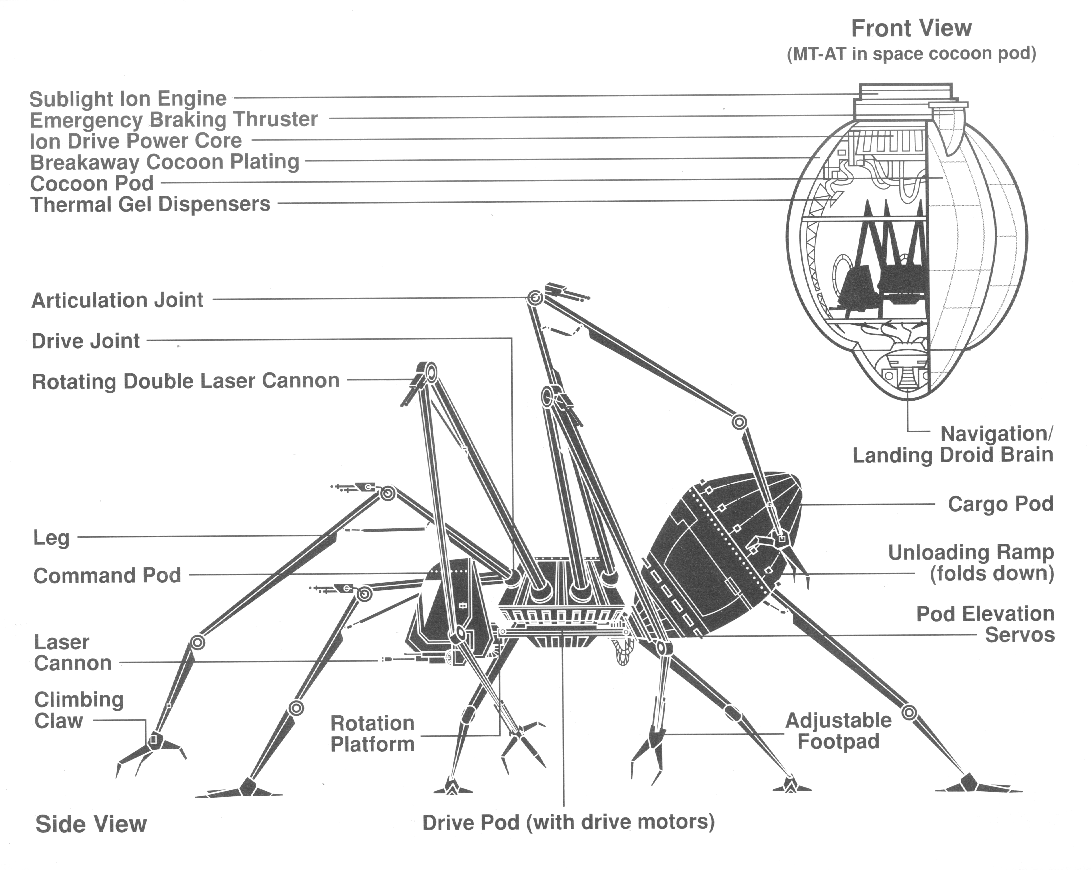
MEMBER ACCOUNT
EMPEROR'S HAMMER
OPERATIONS
- Battle Center
- Patch Archive
- Competition Center
- Combat Center
- Imperial University
- Mission Creation Center
- Fiction Center
DATA CENTER
- Killboards
- Squadron Battleboards
- Pilot Statistics and Ranks
- Medal Board
- Uniforms
- Roster Tools
- Complete Craft List
COMMUNICATIONS
EH SUBGROUPS
REFERENCE & MANUALS
- Encyclopaedia Imperia Wiki
- TIE Corps Pilot Manual
- SO Dark Side Compendium
- COO Manual
- Tactical Manual
- Fleet Manual
- Training Manual
- System Manual
- Fleet Order of Battle
EH POLICIES & INFO
UTC
Vehicle Course - Stage 3 Notes
Introduction
The All Terrain Scout Transport and the Mountain Terrain Armoured Transport
Glad to see that you have decided to continue! This is the third stage of your Vehicle Specialist training. In this stage of the course you will move on from your knowledge of the AT-PT to learn about to larger Imperial Walkers, the All Terrain Scout Transport (AT-ST) and the Mountain Terrain Armoured Transport (MT-AT).
The All Terrain Scout Transport (AT-ST)
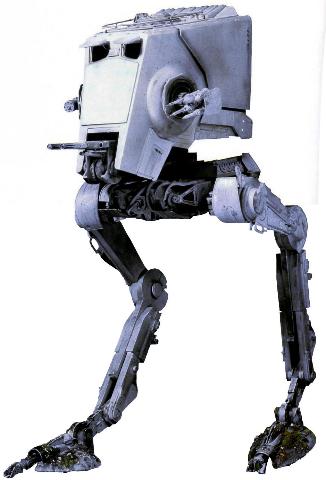 Name/Model: All Terrain Scout Transport (AT-ST)
Name/Model: All Terrain Scout Transport (AT-ST)
Designer/Manufacturer: Constructed for the Hammer’s Fist on Carrida II.
Combat Designation: Scout Transport/Medium Assault Walker
Scale of Vehicle: Walker
Height: 8.6 Metres
Length: 6.4 Metres
Crew: 2 (Pilot and Co-Pilot)
Skeleton Crew: 1
Troops: None
Cargo Capacity: 200 kg
Weapons:
1 Chin Mounted Twin Blaster Cannon
1 Port Side Cockpit Mounted Twin Light Blaster Cannon
1 Starboard Side Cockpit Mounted Concussion Grenade Launcher
Maximum Speed: 90 kph (On flat, stable terrain)
All Terrain Scout Transport (AT-ST) Walkers are smaller than the behemoth like AT-ATs however they are far more agile. The AT-ST was designed primarily for reconnaissance and scouting missions and in this role is often deployed alone. AT-STs are also excellent patrol vehicles and other mission profiles for it is typically used include perimeter defence, anti-personnel hunting, support for Imperial Ground Troops and AT-AT support. This walker is used in extensively within the Hammer’s Fist as direct reinforcements for front-line battles, to provide cover fire for advancing troops and often they move along side AT-AT formations to clear out enemy ground troops who believe that they can take safety beneath or behind advancing AT-ATs. On top of that, their manoeuvrability allows them to cover the AT-AT flanks. They have earned a reputation as quick and manoeuvrable escorts for ground-based attack forces.
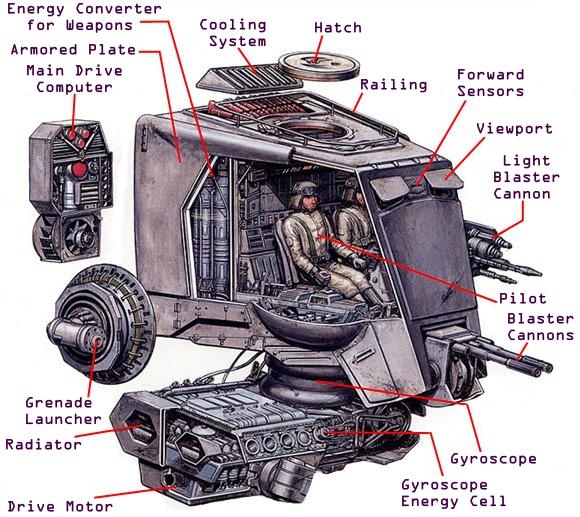 The walker can be quite devastating in combat especially against infantry and light repulsorlift vehicles. While AT-ATs crush main Rebel defensive emplacements, AT-STs ferret out small pockets of Rebel soldiers. When as used per original design specifications, the AT-ST consistently outperforms comparable repulsorcraft. Its flexibility and its firepower make the AT-ST a strong addition to the battlefield. Due to the great speed of this lightweight walker, heavy armour is not needed. Speed is the AT-ST's primary defence. Almost impossible to flee on foot from the AT-ST, the sight of them patrolling strikes fear into isolated ground troops. Unfortunately the AT-ST is too small to carry an onboard full-power generator; the AT-ST uses disposable high-intensity power cells to feed its power-intensive systems. However, these power cells limit the range of the AT-ST.
The walker can be quite devastating in combat especially against infantry and light repulsorlift vehicles. While AT-ATs crush main Rebel defensive emplacements, AT-STs ferret out small pockets of Rebel soldiers. When as used per original design specifications, the AT-ST consistently outperforms comparable repulsorcraft. Its flexibility and its firepower make the AT-ST a strong addition to the battlefield. Due to the great speed of this lightweight walker, heavy armour is not needed. Speed is the AT-ST's primary defence. Almost impossible to flee on foot from the AT-ST, the sight of them patrolling strikes fear into isolated ground troops. Unfortunately the AT-ST is too small to carry an onboard full-power generator; the AT-ST uses disposable high-intensity power cells to feed its power-intensive systems. However, these power cells limit the range of the AT-ST.
Armour plating protects the entire command cabin, it also has closable view ports for the Pilot and the Co-Pilot. However, the AT-ST does maintain thick durasteel armour for maximum protection against small-scale blasters, but repeating blasters and other large-scale weapons have sufficient power to cause body damage. Just like in the mighty AT-AT, the AT-ST has a holographic targeting system that provides a 360-degree view of the battlefield as well as range and targeting information. On either side of the command cabin are sensor pods that are located behind the weapons.
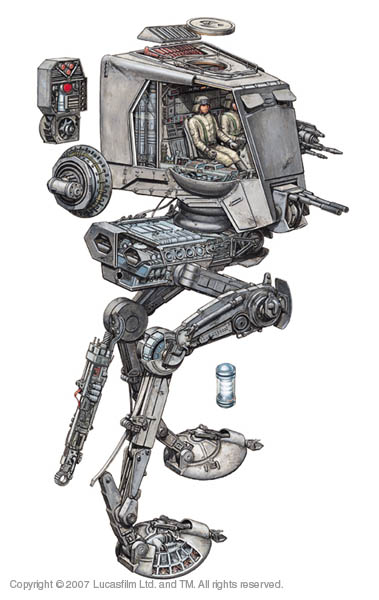 The two-legged drive system allows for greater speed, however they are more unbalanced than the AT-AT's drive system. This is in fact, the only major flaw of the AT-ST. With an expert pilot at the helm, an AT-ST can move with remarkable agility across a wide variety of terrain. Its powerful gyrostabilizer coupled with a complex locomotion system allows the AT-ST to mimic the walking movements of a living creature. While the computer can guide the walker over even ground, an expert human pilot must balance the wide variety of data input and control the craft's walking in difficult terrain. Sophisticated shock-absorbing systems within the legs of the walker keep it stable and feed balance data into the navigation computers. Also ground impact sensors in the footpads offer detailed feedback on the terrain ahead, reading the density and contour for precise foot placement.
The two-legged drive system allows for greater speed, however they are more unbalanced than the AT-AT's drive system. This is in fact, the only major flaw of the AT-ST. With an expert pilot at the helm, an AT-ST can move with remarkable agility across a wide variety of terrain. Its powerful gyrostabilizer coupled with a complex locomotion system allows the AT-ST to mimic the walking movements of a living creature. While the computer can guide the walker over even ground, an expert human pilot must balance the wide variety of data input and control the craft's walking in difficult terrain. Sophisticated shock-absorbing systems within the legs of the walker keep it stable and feed balance data into the navigation computers. Also ground impact sensors in the footpads offer detailed feedback on the terrain ahead, reading the density and contour for precise foot placement.
However, when used in their support role, the speed and formidable firepower more than makes up that weakness. The port and starboard weapons are particularly useful against ground troops. The single drive system that powers the legs is unfortunately entirely exposed to enemy fire, however enemy troops must get close enough for pinpoint targeting to take advantage of this weakness. An advanced gyro system maintains balance, however the unit is susceptible to damage or collapse. The AT-ST is able to walk through denser terrain with greater ease, travelling through small canyons or forests that would stop an AT-AT. While excellent on the open ground, it can be slowed by dense foliage, uneven terrain or by hidden traps. These traps could be covered pits, trip-wire explosives and water or oil filled trenches that could be set ablaze. Because AT-STs can fall prey to these traps, troops on foot usually move into battle areas first to check for such defences.
The drive unit allows these walkers to work through terrain that would stop traditional repulsorlift vehicles. The "head" can turn independently from the drive and leg system to fire in all directions. It is difficult to target the AT-ST since it is very hard to get one to sit long enough to make it possible to hit one. For the Battle of Hoth the AT-STs that participated at that battle were somewhat modified for cold weather environment. The access hatch is located on top of the command cabin. The crew can climb up the side of the walker by using a series of handholds to get to the access hatch, however at Hammer’s Fist military bases the crew use the loading platform to gain access to the AT-ST. Between the two forward view ports is the forward sensor. Behind the access hatch is the cockpit cooling system. And behind the pilots in the cabin, is the weapons power converts and behind that is the locomotion computer. The gyro system is what connects the "head" to the rest of the walker. In the aft section, below the "head" of the walker are located two radiators and the exhaust. This section also holds the power cells on either side of it.
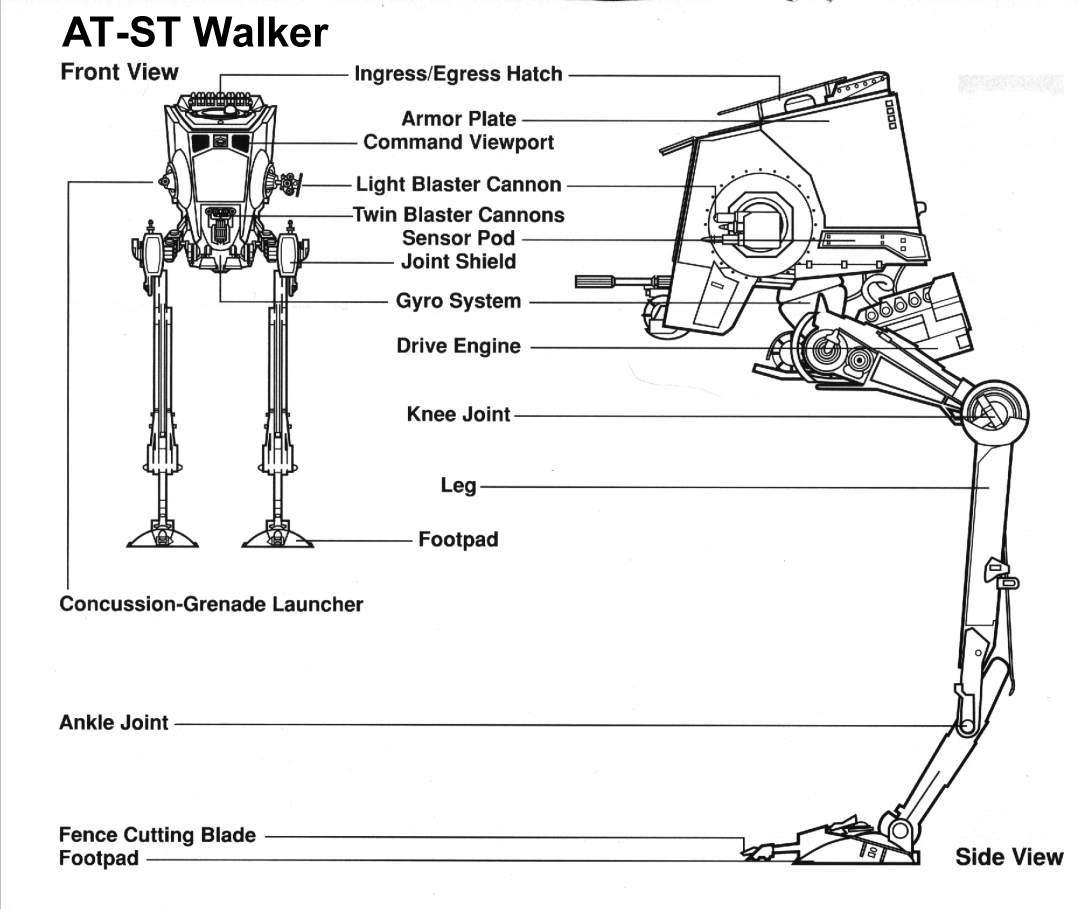
The Mountain Terrain Armoured Transport
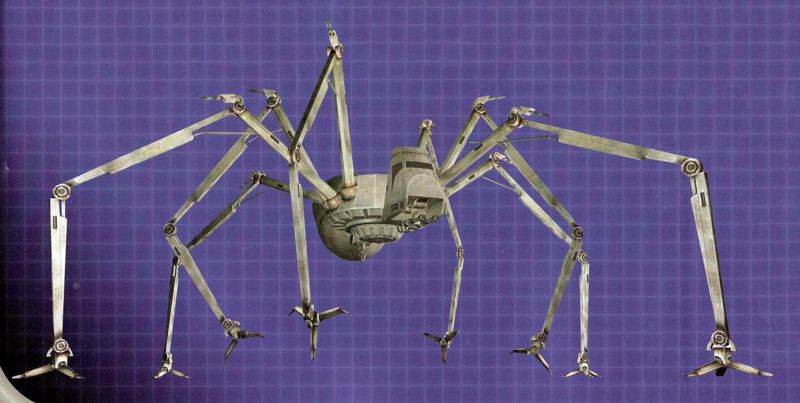
Designer/Manufacturer: Originally designed on Carida. Constructed for the Hammer’s Fist on Carrida II.
Combat Designation: Scout Transport/Medium Assault Walker
Scale of Vehicle: Walker
Height: 8.6 Metres
Length: 15.6 Metres
Crew: 2 (Pilot and Co-Pilot)
Skeleton Crew: 1
Troops: None
Cargo Capacity: 300 kg
Weapons:
8 twin blaster cannons (leg joints)
2 laser cannons (chin)
Maximum Speed: 130 kph (On flat, terrain)
The Mountain Terrain Armoured Transport (MT-AT) was developed on Carida under the orders of the planet's defacto civil ruler, Ambassador Furgan. The project was started about a year before the reappearance of Grand Admiral Thrawn. About six months into the project, the Imperial Star Destroyer Grey Wolf visited the Carida system under the guise of military exercise. With a false IFF code, they were able to stay in system long enough for a team of commandoes and intelligence operatives, sent by Grand Admiral Ronin to get into the main design bureau and steal the plans for the MT-AT.
Upon their return, the plans were immediately handed over to Hammer’s Fist technicians and engineers who immediately set to work on constructing several models for testing and evaluation. As with the AT-PT before it, Prefect of the Legion Ares and his General Staff were suitably impressed with the abilities of the MT-AT and permission was given for it to be put to immediate production.
Due to this being a very recent occurrence, the Hammer’s Fist still only has a limited number of MT-ATs and their use is therefore also limited. As more MT-ATs become available it is hoped that their use will become more widespread throughout the Hammer’s Fist and the Emperor’s Hammer as a whole. The MT-AT has an impressive future ahead of it. Let us hope that you, Vehicle specialists can help realise that future.
The MT-AT is intended for operations requiring the traversal of seriously rugged mountainous terrains. It is much more dextrous and agile than regular walker classes, and its eight clawed legs enable it to find a very secure foothold . The greater number of limbs makes the MT-AT more trip-proof than the AT-AT, and provides better weight distribution for movement across unstable land. Its chief advantage is the ability to access ordinarily impenetrable positions, but not necessarily to act as a domineering juggernaut.
This is the only known walker design to mount weapons anywhere other than the main hull and head. Each of the legs has a swivelling blaster cannon on the elbow joint. Aiming these continually moving guns can prove to be a considerable problem, unless the gunner is aided by the semi-automated systems that drive the vehicle. (The gunner is one of only two crewmen who handle the complex machine.) The larger chin-mounted laser cannons are intended for defence against flying foes.
As the current version of the MT-AT is only capable of carrying a squad of Stormtroopers or supplies, work has begun on designing a larger version of the walker. This larger MT-AT, dubbed the Mountain Terrain Heavy Armoured Transport (MT-HAT) is still some time away from being even a prototype, however it is believed that when completed the MT-HAT will be able to fulfil the role of the AT-AT in terrain that would normally be completely inaccessible to troops and vehicles. The new walker will have to be deployed by landing barge in the same manner as the AT-AT. This is because that while current MT-AT’s are deployed in an impact resistant coccon, engineers have been unable, at present, to scale up the technology for something as large as the projected size of the MT-HAT.
